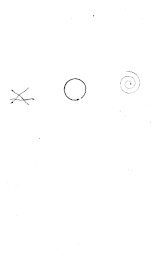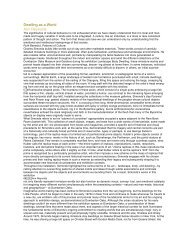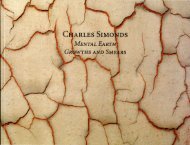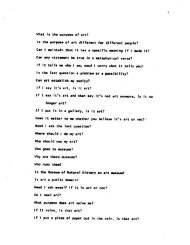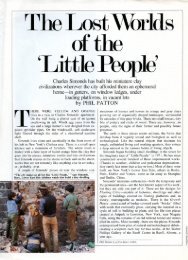Read Catalog - Charles Simonds
Read Catalog - Charles Simonds
Read Catalog - Charles Simonds
You also want an ePaper? Increase the reach of your titles
YUMPU automatically turns print PDFs into web optimized ePapers that Google loves.
The third landscape also shows us the first signs of future<br />
directions; it is from the domes and the phallic tip erupted from<br />
within the folds at center that the Circles and Towers respectively<br />
evolve: all the possibilities are here. The dualities of sex,<br />
female and male, are thus established early, the one implied<br />
before the other, as the generative forces that determine the<br />
course both the Circles and Towers follow during their evolution.<br />
As <strong>Simonds</strong> specified,3 the work follows the evolution<br />
both of a landscape and of an architecture, the one identified<br />
with earth, water, growth, nature, the horizontal, female; the<br />
other with ordering the earth, fire, construction, erection of the<br />
vertical, and male. During the cycle the earth "is digested into<br />
architecture," and eventually "all landscape things have become<br />
built things."4 What grew becomes built.<br />
These simple, rather fundamental dualities are established in<br />
the third landscape but without being codified into fixed laws.<br />
Here is both juxtaposition and ambiguity of genders-are the<br />
protrusions on the domes nascent phalli, nipples, lips or womb?<br />
Although the question is not really answered-the Circles and<br />
the Towers are offered as two possibilities-we sense that the<br />
idea of dualities underscores the mutual give-and-take of existence,<br />
the importance of a dynamic balance of forces. Neither<br />
gender is entirely absent in the 12 landscapes-the principle of<br />
evolutionary growth for higher life-forms assumes the variety<br />
ensured by sexual reproduction.5 The degree to which one or<br />
the other dominates, however, is the key to inferring whether a<br />
particular landscape is in balance, and, if not, what this may<br />
mean: is the structure and/ or its details becoming more complex-attaining<br />
a higher level of civilization-or is it in stasis<br />
or decline? If the Circles (feminine principle) are nevertheless<br />
all constructed (male), not grown (female), is the structure or<br />
process organic and therefore female in emphasis, or simply<br />
additive? Does the construction reinforce the forms of the<br />
landscape or deny them? Thus the primary image of the hermaphrodite<br />
discussed above also functions as an elaborate<br />
ecological metaphor, this time reading nature and civilization;<br />
or again, that which grows and that which is built, found or<br />
structured. Such are the terms, both the obvious and the less<br />
familiar, and the kinds of questions one must ask, because in<br />
<strong>Simonds</strong>'s civilizations, as in traditional cultures, most everything-each<br />
detail-relates to a larger whole.6<br />
Number 4 (pl. 35)<br />
The fourth landscape is the first of the Circles that we see following<br />
up on the possibilities established in Number 3. Discounting<br />
the wooden paths and ritual markers appearing there,<br />
this fourth landscape shows the first evidence of actual construction.<br />
Most of this activity occurs near the center, on the<br />
central dome now covered with multicolored bricks in a random<br />
pattern with annuary poles placed in the masonry to catch the<br />
first rays of the sun on specified days of celebration. Some of<br />
the smaller domes also have been modified for habitation.7 The<br />
orientation of their rectangular doorways suggests the daily<br />
patterns of family groups or other affiliations which we infer<br />
from the clusters of isolated openings; all are turned away from<br />
the sacred center. Three new elevated masonry structures have<br />
also appeared corresponding to three corners of the square; the<br />
fourth holds an isolated phallic mound. All three structures are<br />
surmounted by what appear to be troughs angled down towards<br />
the central opening; like the annuary poles, the sightlines established<br />
by the elevated structures are to be viewed from within<br />
the central dome: all are aids to observing celestial events. A<br />
single worn, curving pathway leads from the edge of the yellow<br />
quadrant-the receding water-to the triangular doorway of<br />
the major dome. All but three of the natural domes have been<br />
adapted or totally transformed into architecture, but these<br />
three are still ringed with ritual markers. Although the dominant<br />
forms are circular and smooth, the incision and erection<br />
of angular geometric shapes have greatly altered the feeling of<br />
the landscape. Triangulated between the raised structures, the<br />
domes no longer blend easily with the flat land, as the hard replaces<br />
what was soft.<br />
Number 5 (pl. 36)<br />
If the time between Numbers 3 and 4 assumed a relatively<br />
modest span of years, we infer that a civilization has already<br />
come and started to decline between Numbers 4 and 5. In the<br />
former everything seems if not new, then of recent origin and<br />
in good condition; by Number 5 we must become archaeologists<br />
to deal with a complex of buildings in obvious disrepair, abandonment,<br />
or ruin.<br />
Working outwards with the construction, we see that the central<br />
dome has been at one time almost completely surrounded<br />
by two concentric rings of buildings; the traces of a third ring<br />
extend toward the siting structure adjacent to the small stream<br />
and elaborate sluiceway. (In his account of the People Who Live<br />
in a Circle, <strong>Simonds</strong> describes the different functions of similar<br />
rings; seep. 36.) It appears that these elevated structures have<br />
been enlarged according to the height of the intervening walls.<br />
Small natural domes, now almost completely bricked over, are<br />
still intact within the inner ring.<br />
Comparison shows that certain details in Number 4 have become<br />
highly structured in Number 5, almost in the manner of<br />
symbols. The protruding lips of the dome/womb in Number 4,<br />
for example, are now formalized in an abstract circle of stone.<br />
And the random integration in the central dome of multicolored<br />
bricks from different areas of the landscape is now a<br />
sophisticated spiral pattern unifying the individual red, yellow,<br />
gray, and pink buildings which constitute the complex as a<br />
whole.8 Bricks dominate the landscape and only a small natural<br />
protrusion (significantly in the small red/pink dome) reminds<br />
us where we began. The central dome and the siting structures<br />
are well-maintained, however, suggesting that whatever else<br />
may have happened to the Little People during this phase, the<br />
underlying cosmogony and rituals are still in some form<br />
preserved.



